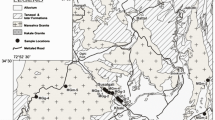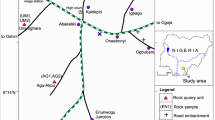Abstract
The petrographical and physical properties of major Precambrian basement rocks in Ado-Ekiti, Nigeria, were evaluated with a view to determine their suitability as road construction aggregates. Fifty rock samples were collected and subjected to petrographic evaluation and laboratory tests (water absorption capacity, specific gravity, Los Angeles abrasion value, aggregate crushing value, aggregate impact value and ten percent fines, flakiness index and unconfined compressive strength). Petrographical analysis revealed that the rocks (migmatite gneiss, quartzite, granite and charnockite) were predominantly acidic, rich in quartzo-feldspathic minerals. Opaque minerals in the rock units ranged between 0.6 and 2.3 % with maximum value in fine-grained charnockite. The specific gravity of the rock aggregates ranged between 2.65 and 2.74. All water absorption capacity values conform to recommended standard value of water absorption capacity <2 %. The aggregate crushing value of the rocks ranged between 17.6 and 28.4 % with minimum from quartzite (17.60–18.40 %) and highest in migmatite gneiss (27.70–28.40 %). The aggregate impact value ranged between 11.0 and 19.0 %, with the lowest value (11.0–11.6 %) from quartzite and highest in charnockite (18.4–19.0 %). Other properties including Los Angeles abrasion, ten percent fines, flakiness index and unconfined compressive strength ranged 17.4–29.8 %, 96.96–131.63 kN, 13 and 24.9 and 138.98–167.52 MPa, respectively. Based on physical and mechanical properties of the rock aggregates in this study, quartzite, and fine-medium grained granites were considered most suitable for road aggregates production as the tests were within the acceptable limits for general road aggregates purposes. Porphyritic granite, the migmatite gneiss and charnockites showed results for which most values were outside, at the margin or slightly within the acceptable limits for general road stone purpose. The geotechnical assessment provided by this study revealed that not all the Precambrian basement rocks would yield aggregates that are satisfactory for use as road aggregates.


Similar content being viewed by others
References
Adebisi NO, Akintayo FO (2012) Geotechnical properties of natural composite rock in Ibadan, Nigeria. Pac J Sci Technol 13(2):448–453
Akesson U, Lindqvist JE, Goransson M (2001) Relationship between texture and mechanical properties of granite, Central Sweden, by use of image-analysing techniques. Bull Eng Geol Environ 60:277–284
Al-Harthi AA (2001) A field index to determine the strength characteristics of crushed aggregate. Bull Eng Geol Environ 60:193–200
Amuboh OT (1999) Geological and geotechnical study of some rocks in Fasola area, Southwestern Nigeria. Unpublished BSc geology project University of Ibadan, Ibadan
Anon (1977) The description of rock masses for engineering purposes. Q J Eng Geol Lond 10:355–388
Anon (1979) Classification of rocks and soils for engineering geological mapping, part 1—rock and soil materials. Rep Commun Eng Geol Map Bull Int Assoc Eng Geol 19:364–371
Arif M, Bukhari SWH, Muhammad N, Sajid M (2013) petrography and physico-mechanical properties of rocks from the ambela granitic complex, NW Pakistan. Sci World J 2013:1–8
ASTM (American Society for Testing and Materials) C127 (1990) Standard test for specific gravity and absorption of coarse aggregate. ASTM International, West Conshohocken
ASTM (American Society for Testing and Materials) C535 (1989) Standard test for resistance to abrasion of large-size coarse aggregate by use of Los Angeles machine. ASTM International, West Conshohocken
ASTM (American Society for Testing and Materials) D692–00 (2004) Standard specification for coarse aggregate for bituminous paving mixtures. ASTM International, West Conshohocken
Bell FG (2007) Engineering geology, 2nd edn. Elsevier, Oxford
Blyth FGH, De Freitas MH (1974) A geology of engineers. ELBS/Arnold, London
BS (British Standard Institution) (1990a) Testing aggregates, 812—part 105: methods for determination of particle shape. Section: 105.1: flakiness index. British Standard Institution, London
BS (British Standard Institution) (1990b) Testing aggregates, 812—part 105: methods for determination of particle shape. Section: 105.2: elongation index of coarse aggregate. British Standard Institution, London
BS (British Standard Institution) (1990c) Testing aggregates, 812—part 110: methods for determination of aggregate crushing value (ACV). British Standard Institution, London
BS (British Standard Institution) (1990d) Testing aggregates, 812—part 111: methods for determination of ten percent fines value (TFV). British Standard Institution, London
BS (British Standard Institution) (1990e) Testing aggregates, 812—part 112: methods for determination of aggregate impact value (AIV). British Standard Institution, London
BS (British Standard Institution) (1992) Specification for aggregates from natural sources for concrete. British Standard Institution, London
BS (British Standard Institution) EN-13043 (2002) Aggregates for bituminous mixtures and surface treatments for roads, airfields and other trafficked areas. British Standard Institution, London
Dada SS, Briqueu L (1998) Pb-Pb and Sr-Nd isotopic study of meta-igneous rocks of Kaduna: Implications for Archean mantle of Northern Nigeria. In: Abstracts of the 32nd annual conference, Nigeria Mining and Geosciences Society, p 57
Dhir RK, Ramsay DM, Balfour N (1971) A study of the aggregate impact and crushing value tests. J Inst Highw Eng 18:17–27
Elueze AA (2000) Compositional appraisal and petrotectonic significance of the Imelu banded ferruginous rock in the Ilesha schist belt, southwestern Nigeria. J Min Geol 36(1):8–18
Eze EO (1997) Geotechnical assessment of some charnockites from Nigeria as construction materials. Q J Eng Geol 30:231–236
Fernlund JMR (2005) Image analysis method for determining 3-D shape of coarse aggregate. Cem Concr Res 35:1629–1637
Fookes PG (1984) An introduction to concrete in the Far East—part 1: concrete, J Concrete Soc 18:38–41
Freedonia (2012) World construction aggregates: industry study with forecasts for 2013 and 2018. The Freedonia Group Inc, Cleveland. Study No. 2838, p 334
Harrison DJ, Bloodworth AJ (1994) Industrial minerals laboratory manual: construction materials BGS technical report WG/94/12, p 100
Hartley A (1974) A review of the geological factors influencing the mechanical properties of road surface aggregates. Q J Eng Geol 7:69–100
Hawkes JR, Hosking JR (1972) British arenaceous rocks for skid-resistant road surfacings. Rd Res Lab Rep No LR 488, Crowthorne
Irfan YT (1994) Aggregate properties and resources of granitic rocks for use in concrete in Hong Kong. Q J Eng Geol 27:25–38
ISRM (International Society for Rock Mechanics) (1978) Suggested method for petrographic description of rocks. Commission for standardization of laboratory and field tests. Int J Rock Mech Miner Sci Geomech Abstr 15(2):43–45
ISRM (International Society for Rock Mechanics) (1979) Suggested methods for determining the uniaxial compressive strength and deformability of rock materials. Commission for standardization of laboratory and field tests. Int J Rock Mech Miner Sci Geomech Abstr 16(2):135–140
ISRM (International Society for Rock Mechanics) (1981) Suggested methods for rock characterization, testing and monitoring. In: Brown ET (ed) Rock characterization, testing and monitoring. Pergamon, Oxford, p 211
Jaeger JC, Cook NGW (1969) Fundamentals of rock mechanics. Chapman and Hall, London
Kahraman S, Fener M (2007) Predicting the Los Angeles abrasion loss of rock aggregates from the uniaxial compressive strength. Mater Lett 61:4861–4865
Kazi A, Al-Mansour ZR (1980) Influence of geological factors on abrasion and soundness characteristics of aggregates. Eng Geol 15:195–203
Korkanc M, Tugrul A (2004) Evaluation of selected basalts from Nigde, Turkey, as source of concrete aggregate. Eng Geol 75:291–307
Krynine DP, Judd WR (1957) Principles of engineering geology and geotechnics. McGraw-Hill, New York
Lindqvist JE, Åkesson U, Malaga K (2007) Microstructure and functional properties of rock materials. Mater Charact 58(11–12):1183–1188
Loberg B (1999) Geologi: material, processer och Sveriges berggrund. 6: ereviderade och utökade upplagan. Prisma. Stockholm (ISBN 91-7297-635-7)
Mallo SJ, Sani SD (2012) Influence of mineralogy and fabric on the engineering properties of the Miango granite porphyry, North Central Nigeria. Int J Modern Eng Res (IJMER) 2(6):4600–4608
McNally GH (1998) Soil and rock construction materials. Spon, London
Miskovsky K, Taborda DM, Kou SQ, Lindqvist PA (2004) Influence of the mineralogical composition and textural properties on the quality of coarse aggregates. J Mater Eng Perform 13(2):144–150
Oyawoye MO (1964) The geology of the Nigerian basement complex. J Min Geol 1:87–102
Pikriyl R (2001) Some microstructure aspects of strength variation in rocks. Int J Rock Mech Min Sci 38:671–682
Rahaman MA (1976) Review of the basement geology of southwestern Nigeria. In: Kogbe CA (ed) Geology of Nigeria. Elizabethan, Lagos, pp 41–58
Rahaman MA, Ajayi TR, Oshin IO, Asubiojo FO (1988) Trace element geochemistry and geotechtonic setting of Ile-Ife schist belts. Precambrian geology of Nigeria. GSN, Kaduna, pp 241–256
Ramsay DM, Dhir RK, Spence IM (1974) The role of rock and clast fabric in the physical performance of crushed-rock aggregate. Eng Geol 8:267–285
Sajid M, Arif M, Muhammad N (2009) Petrography and engineering properties of rocks from Khagram-Razagram area, Lower Dir district, NWFP, Pakistan. J Himal Earth Sci 42:25–36
Smith MR, Collis L, Fookes PJ (2001) Aggregates: sand, gravel and crushed rock aggregates for construction purposes, geological society, engineering geology special publication 17. The Geological Society, London, p 339
Talabi AO (2013) Mineralogical and chemical characterization of major basement rocks in Ekiti State, SW-Nigeria. RMZ—Materials and Geoenvironment, vol 60, pp 73–86
Talabi AO, Tijani MN (2013) Hydrochemical and stable isotopic characterization of shallow groundwater system in the crystalline basement terrain of Ekiti area, southwestern Nigeria. Appl Water Sci 3:229–245
Waltham T (2009) Foundations of engineering geology, 3rd edn. Spon, London
Author information
Authors and Affiliations
Corresponding author
Rights and permissions
About this article
Cite this article
Afolagboye, L.O., Talabi, A.O. & Akinola, O.O. Evaluation of selected basement complex rocks from Ado-Ekiti, SW Nigeria, as source of road construction aggregates. Bull Eng Geol Environ 75, 853–865 (2016). https://doi.org/10.1007/s10064-015-0766-1
Received:
Accepted:
Published:
Issue Date:
DOI: https://doi.org/10.1007/s10064-015-0766-1




